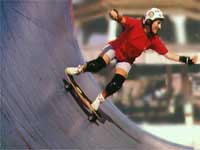Surfing takes to the streets, kicking out a fashion revolution
Skateboarding requires balance, deft footwork and more than a little attitude. Fortunately for the rest of us, none of these attributes are necessary to look like a skateboarder - all you need is a pair of cool name brand flat-sole shoes, a short-sleeve checked cotton shirt and the baggiest trousers available, perhaps accompanied by a low-hanging key chain.
| FROM THE ARCHIVES ...
 With the skateboard craze sweeping the nation, Sports Minister Rt Hon Dennis Howell warns prosecution will not stop youngsters knocking down old ladies on footpaths With the skateboard craze sweeping the nation, Sports Minister Rt Hon Dennis Howell warns prosecution will not stop youngsters knocking down old ladies on footpaths
- PM, 1978 (RealAudio)
|
For, just like its surfing forebear, the greatest impact of skateboarding is not board-riding itself but the generation-defining slacker fashion statements that go with the sport.
Without skater culture, we�d all be forced to wear stiff leather shoes and collared shirts to venture into any pub or club. Indeed, we�d probably be so busy ironing clothes that we�d have little time to 'hang out' (not that we�d know that concept).
Skating through history
Historians generally believe that the first skateboards were created in the 1950s by surfers in California who attached roller skates to their long boards. �Sidewalk surfing� was regarded as an inferior substitute for wave riding, but the two cultures have always enjoyed many shared characteristics and icons.
 The first commercial product, the Roller Derby Skateboard, went on sale in 1959, and an estimated 50 million boards were sold by 1965. These primitive skateboards were often around an inch thick, with narrow trucks and hard clay or rubber wheels making for a rough ride.
The first commercial product, the Roller Derby Skateboard, went on sale in 1959, and an estimated 50 million boards were sold by 1965. These primitive skateboards were often around an inch thick, with narrow trucks and hard clay or rubber wheels making for a rough ride.
Cult brands, such as Hobie Skateboards, established in 1964 by surfing legend Hobie Alter, were a hallmark of skateboarding culture from the very start.
Distinctive skate punk music styles took longer to develop than the surf rock sound perfected by the Beach Boys, but the speed and close-range action quickly fuelled cinematic fires. The first widely released skateboarding movie was Skaterdater, written and directed by Noel Black in 1965.
Reckless pursuits
Humans being cliquey and competitive by nature, skateboarders soon began to organise events within genres such as freestyle, slalom and downhill, as well as high and long jumping.
 Seeking new horizons, boarders took to concrete drainage channels and even empty swimming pools as venues for vertical riding.
Seeking new horizons, boarders took to concrete drainage channels and even empty swimming pools as venues for vertical riding.
Pool owners weren�t the only ones upset - politicians regularly condemned skateboarders for �reckless� riding on streets and footpaths, knocking down old ladies and generally creating mayhem.
Even today, dedicated skateboarding parks, a multi-million pound industry behind the sport and mainstream embrace of kerb-surfing dress sense have done little to dispel the image of skateboarding as the urban rebel�s pastime.
